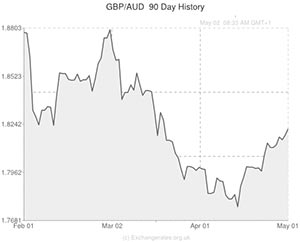
The Pound to Australian Dollar exchange rate (GBP/AUD) remained close to 1.8000 last night despite data showing that output in Australia’s largest trading partner improved during May.
The Chinese manufacturing PMI rose from 50.4 to 50.8 in May, marking the best monthly score for five months. A surge in new orders helped drive the highly watched purchasing managers index higher in a sign that economic output is beginning to stabilise in the world’s second largest economy. Analysts had previously voiced concerns over the state of the Chinese economy, which had shown signs of cooling.
As China is the largest buyer of Australian exports, robust Chinese data is usually seen as a bullish signal for the ‘Aussie’ Dollar. However, on this occasion the Sterling to Australian Dollar exchange rate (GBP/AUD) remained fairly resilient following the upbeat data release.
The Pound to New Zealand Dollar exchange rate (GBP/NZD) also managed to avoid defeat in the aftermath of the Chinese report, which would usually boost the Antipodean currency. The ‘kiwi’ has struggled against the Pound over the past few days due to concerns that softer commodity prices could persuade policymakers at the Reserve Bank of New Zealand to halt the hiking cycle.
The Australian AiG PMI came in at 49.2 for May. Although the report marked the seventh consecutive month of contraction it saw the headline index rise by almost five points from 44.8. Both production and new orders increased but the latest federal budget caused business confidence to fall and exports were impacted by the relatively high value of the domestic currency.
GBP to AUD did not deviate strongly following the release.
Later this morning data is expected to show that British manufacturing activity improved at a pace of 57.0 during May. Recent PMI results have beaten economists’ forecasts and therefore bolstered bets of an interest rate hike from the Bank of England. If this morning’s data also beats expectations then it is likely to bolster demand for the Pound.
The same goes for construction data released on Tuesday and service sector data released on Wednesday.
The Bank of England is due to make a decision on monetary policy on Thursday. It is widely anticipated that the bank will opt to maintain its current interest rate of 0.50% and refrain from adding to the £375 billion asset purchase target.
Recent comments from some policymakers suggest that the interest rate debate may start to heat up in the coming months but it is very unlikely that we will see a majority vote in favour of raising rates for at least another few months, most likely not until next year.

Comments are closed.